One of the oldest churches in North Carolina was destroyed in a devastating fire. The fire marshal started conducting interviews to figure out what may have caused the blaze to destroy the historic landmark.
The Second Creek Methodist Church, originally established as an AME Zion church, has been located on Gheen Road since it was built in 1867. But right before midnight on Wednesday, June 15, all of that history went up in smoke after a fire ravaged the edifice.
Firefighters said, according to WSOC, by the time they arrived on the scene, almost 75 percent of the building was aflame. The officers worked diligently to prevent the fire from spreading over to the former school house on the church’s property.
The school house in modern times has been transformed into a residence by Paul Blackwell for his family, according to his daughter Francis Young.
Young said, in an interview with the Salisbury Post, that she grew up as a congregant at the church, a worship space that her grandfather, William Blackwell, donated the land that both two buildings were situated on, and attended the school up until the third grade.
Born in 1941, Young has witnessed the church change in a lot of ways, and what she didn’t see, she learned from the community. The Blackwell and Carson families “owned or managed” the property, she stated, and her mother and father are buried in the cemetery on the church near the Gheen Road side, and other relatives in the original cemetery on Holt Road.
“The church was originally on what is now Holt Road,” she said. “The street didn’t have a name at that time. We called it ‘The Bottoms’ because it was way down there. But my family took the church and moved it, plank by plank, on a wagon, to the place it is now.”
Young’s family lived in the school house after her mother passed away in 2000. At that point, she and other family members moved from the property but retained ownership.
She says she attended the church until the 1970s, leaving only after marrying an AME Zion pastor. The church shifted denomination from AME Zion to Methodist in the 1950s, which was the affiliation until consistent Sunday services stopped. Young said “in about 1980, I think, the church closed because the older members had died and the younger family members moved away, so there was no congregation. So, the church has been closed for 50 years.”
Rowan County Fire Marshal Deborah Horne noted the first call about the fire “came in at 11:26 p.m. Wednesday night from a neighbor out walking the dog who spotted the flames.”
Other calls started to pour in, one from a motorist driving home who saw the fire and another from a nearby neighbor.
Now, she and her team are working to get answers about how the fire started.
“Right now, we’ve gone house to house and conducted interviews and surveyed the area,” she said. “And we’ll start on the actual structure in the morning.”
Joining their investigation will be the North Carolina State Bureau of Investigation, Rowan County Sheriff’s Office, and the Department of Alcohol, Tobacco, and Firearms.
Despite the church not having worship services in decades, the loss of a space with such historicity is painful for the entire community.
Young believes in 2012, when the Historic Salisbury Foundation paid for some repairs, including a new roof on the building, they wanted to engage the tedious process of having the 155-year-old church designated a historic building. She is unsure if it ever happened.
The foundation does not list the sanctuary as a designated site on its website. The Hall House, Grimes Mill, Salisbury Railway Passenger Station, and Salisbury Ice House are landmarks supported by the organization. Not one of the four attractions has a substantial connection to the Black community. The Second Creek Methodist Church would have been the first.
Now, the woman that used to call the church home is heartbroken. The possibility of it becoming a landmark is gone and the place where she grew up is no more. Young said, “I just can’t believe this is true. That church has been a part of my life all of my life.”


